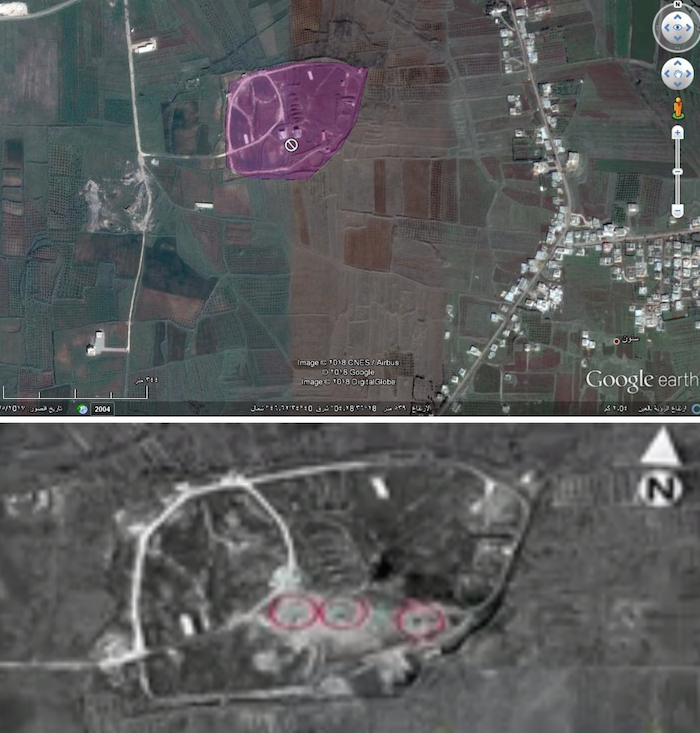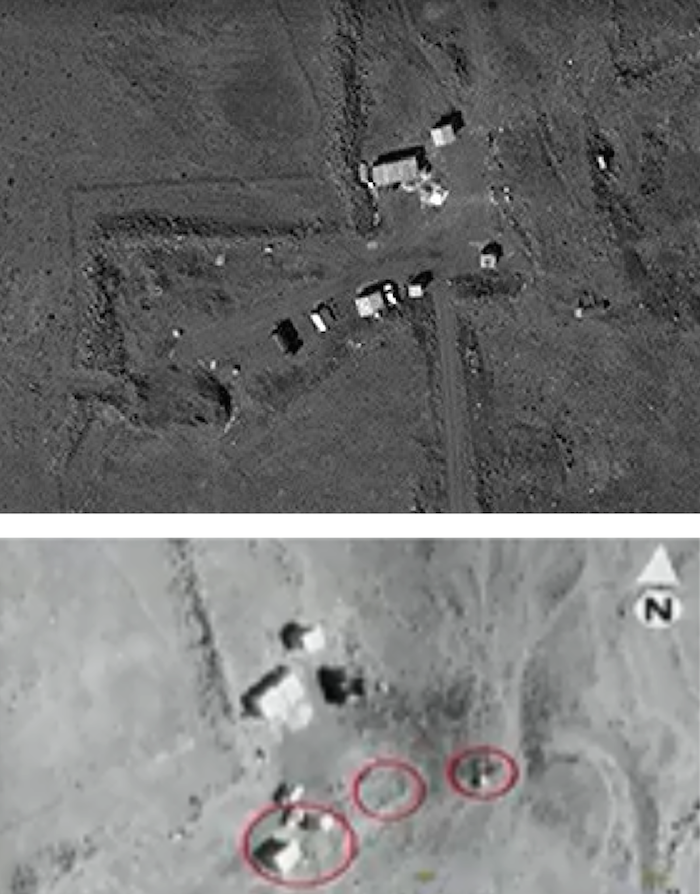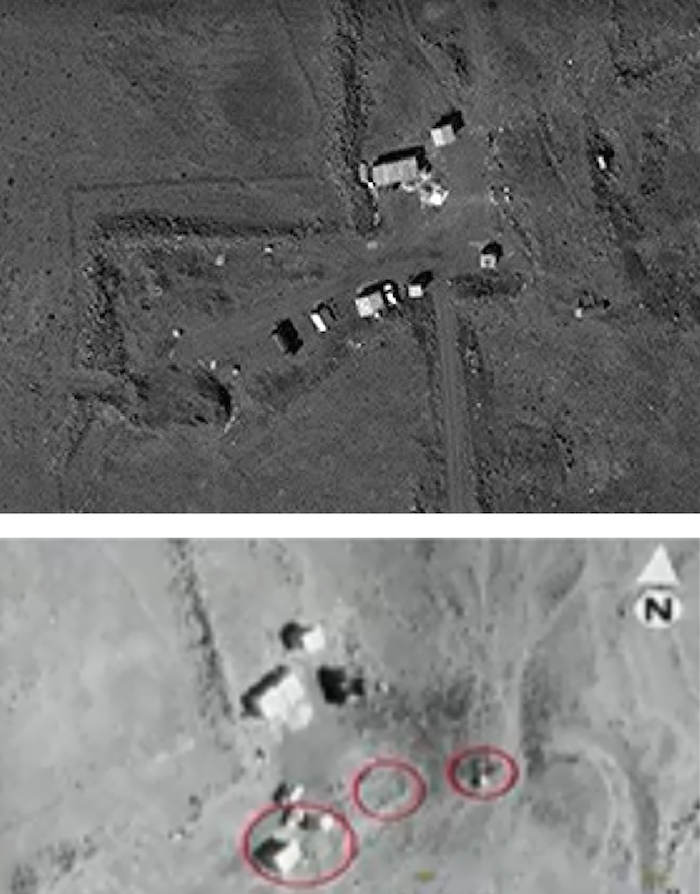(Zaman Al Wasl)- Syrian air defense systems failed to intercept any of the U.S.-British-French missiles, reducing the entire chemical facilities to rubble, a military source told Zaman al-Wasl.
The source, who supplied Zaman al-Wasl with satellite images for Institute 6000 in Homs province, said the joint airstrikes were destructive, refuting regime allegations.
Brig. Gen. Ali Mayhoub, who read the the military statement on state TV, said "our air defenses effectively shot down most of them." He says one of the missiles hit the Scientific Research Center in Barzeh near Damascus, damaging a building. In Homs, one of the missiles was derailed injuring three people, he said.
The Pentagon said Saturday that the joint operation against the regime had "successfully hit every target," countering assertions from Russia and the Assad army that dozens of missiles were intercepted.
U.S., Britain and France fired 110 missiles during a joint attack on targets in Damascus and Homs.
Mayhoub says the attacks "will not deter" the Assad military from its ongoing war to eradicate "armed terrorists" from Syrian territory.
The strikes came after the Assad regime was accused of carrying out a chemical attack in Syria's Douma, which killed 78 civilians and injured hundreds of others.
The three allies used ships, a submarine and warplanes to launch a barrage of 105 guided missiles towards three chemical weapons facilities in Syria, officials said, including a research center on the outskirts of Damascus.
The strikes "will significantly impact the Syrian regime's ability to develop, deploy and use chemical weapons in the future," said Lieutenant General Kenneth McKenzie, director of the U.S. military's Joint Staff, though he noted a "residual" element remained.
The missiles struck their targets within a minute or two of each other, McKenzie said, impacting around 4:00 am Syrian time (0100 GMT).
The overnight operation was the culmination of a week of frenetic planning at the Pentagon, with officials weighing the risks of various targets as President Donald Trump sent out mixed messages on what he wanted to do.
"All the options looked at ways to balance minimizing collateral damage against maximum effect. These three targets seemed to hit the sweet spot and do that," McKenzie said.
He said there were no known civilian casualties, but noted Syria had fired about 40 unguided surface-to-air missiles, most of which didn't launch until after the allied strike was over. These missiles may have come down in populated areas, he said.
"When you shoot iron into the air without guidance, it's going to come down somewhere," McKenzie said.
The Russian military said that 103 cruise missiles were fired including Tomahawk missiles, but that Syrian air defense systems managed to intercept 71 cruise missiles.
McKenzie countered that "the Syrian response was remarkably ineffective in all domains."
According to U.S. officials, the operation comprised three U.S. destroyers, a French frigate and a U.S. submarine. The vessels were located in the Red Sea, the Gulf and the eastern Mediterranean.
The U.S. Air Force fired air-launched cruise missiles from B-1 bombers, and French and British planes also shot cruise missiles toward the targets.
The operation was "precise, overwhelming and effective," McKenzie said, adding it will set their chemical weapons program back "for years."
Pentagon spokeswoman Dana White reiterated that the United States is only in Syria to fight Daesh (ISIS) and does not want to get drawn into Syria's civil war.
"We do not seek conflict in Syria, but we cannot allow such grievous violations of international law," she said, referring to the suspected chemical attack.
"We successfully hit every target," she said.
"The strikes were justified, legitimate and proportionate."

At least 20 militants loyal to Bashar al-Assad killed in the British airstrikes on chemical sites in Homs, local activists said Saturday.
The two sites were a center for scientific research, which specialized in manufacturing the chemical weapons, and army depots where the chemical products are being stored.
Both sites are located in the western countryside of Homs, a pro-regime area controlled by allied militias.
Ahmed Suleiman (pseudonym) said the research center in the town of Nuweiha, 17 km (11 miles) west of Homs, is specialized only in the production of chemical weapons in cooperation with the Syrian Atomic Energy Commission.
The British defense ministry said the "initial indications" showed that the pre-dawn airstrikes were a "successful attack".


"A perfectly executed strike," President Donald Trump tweeted Saturday in the aftermath of his second decision in two years to fire missiles against Syria. "Could not have had a better result. Mission Accomplished!"
The UN Security Council on Saturday rejected Russian resolution condemning the joint airstrikes.
The Security Council convened an emergency meeting at the request of Russia, which condemned US-led airstrikes on Syria overnight.
The resolution was rejected as it failed to get 9 votes in favor from 15-member council.
China and Bolivia voted in favor of the resolution, while the U.S., U.K., France, Sweden, Poland, Ivory Coast, Kuwait and the Netherlands opposed it.
Peru, Kazakhstan, Ethiopia and Equatorial Guinea abstained.
Syrian people, in complete violation of international law," she said.
Vassily Nebenzia, Russia's ambassador to the UN, condemned the airstrikes as “hooliganism in international relations.”
“Russia condemns attack against Syria. The U.S. actions in Syria make the present destructive situation even worse,” Nebenzia added. (With agencies)
Zaman Al Wasl
















Comments About This Article
Please fill the fields below.